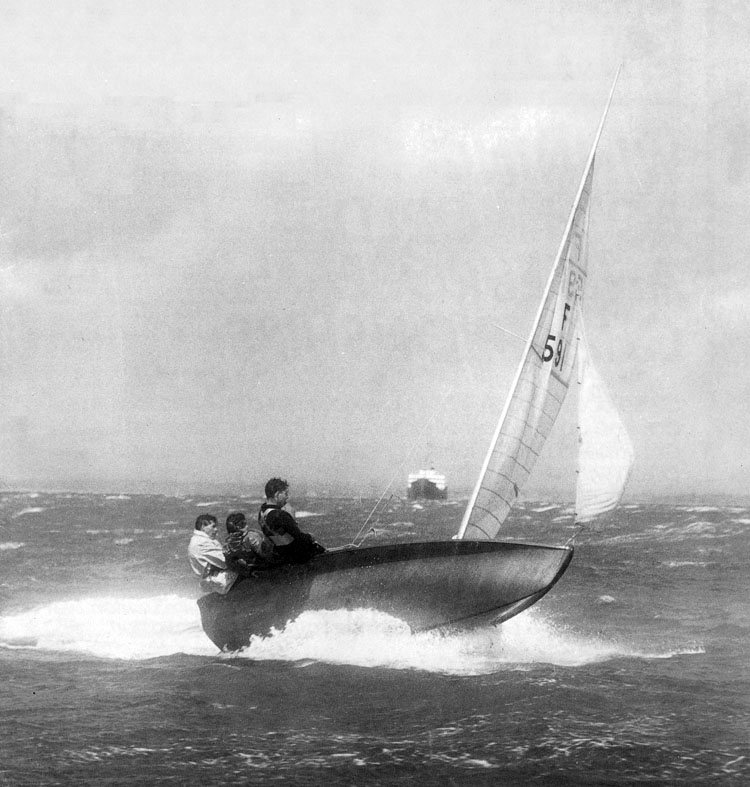IMPRESSION OF THE 505
from the International 505 Class Magazine -1965
Richard Creagh Osborne,
one of the most
prestigious British helmsmen,
entrusts here his first contacts with the 505 to us.
It hardly seems ten years since I saw in "Yachts & Yachting" the first announcement of the Five-o-Five in Britain. There was a description and a lines plan and I was immediately impressed by the undoubted excellence of the hull shape and the whole modern conception of the boat.
With hardly another thought I wrote off to John Westell that I would certainly build one of these craft and asked if he would get me a sail number. Derek Pitt-Pitts said he would join me, and together we built "Ricochet" from a Fairey Marine shell with sail number 4 � the first boat outside France.
Whilst "Ricochet" was building we were kindly lent the prototype "Fairey Tale" by Fairey Marine, and we gave her a very thorough testing in the strong winds which prevailed that summer.
We were completely enchanted by the boat and felt that we could handle her in any conditions we were likely to meet. In fact, during Cowes Week we took her out with a crew of three and a Firefly sail of 9 square metres in a wind strength measured at Calshot, 3 kilometres to the north, of 60 knots!
The result was the fabulous series of photographs taken by Beken, which were featured in yachting magazines all over the world. The Five-o-Five was immediately brought to the notice of the world by this lucky occasion, and we knew also that we had a boat which was safer, more controllable, more exciting and more suitable for every sort of weather from Swiss lakes to Australian storms, than any other boat in the world.
The design had light weight, modern lines, great power when needed, but low wetted surface for light weather, a large efficient spinnaker, and a trapeze. There was also the good possibility of construction in plastic and there was a sound set of rules to keep all boats the same speed.
Immediately there started the battle with the Flying Dutchman for Olympic selection. We fought hard but the battle was lost before we had begun. The Olympic Games Rules at that time gave the host country the choice of classes and the Italians already had a fleet of Flying Dutchmen which had been designed two years earlier, and did not want to build a fleet of different boats. The rules were changed immediately afterwards.
We all know the main arguments-the speeds are very little different, but the Five-o-Five is much smaller, easier, and cheaper to build, and easier to handle in and out of the water. The Five-o-Five is quicker tacking and therefore can use the course better. One day perhaps we may still see this boat recognised officially as the world's top onedesign.
When we were in Melbourne Paul Elvstr�m, Erik Olsen, Roger Tiriau, myself and others, persuaded the Australians to start fleets of Five-o-Fives. They did so, and it is with great pleasure that I saw that their very first entry in the World's Championship was the winner. This will give the fleets in Australia great encouragement and reward for their faith, and will ensure the expansion of the Class in the southern hemisphere.
Derek and I raced 'Fairey Tale", and then "Ricochet" for four years. It took us to Ouistreham for that splendid first International Team Match; to La Baule where my chief memory was of the most exciting race of my life in very strong winds, when Elvstr�m and Poullain, Lebrun and Harinkouck, and ourselves were overlapping at every mark of the long, tough, special course.
There was also splendid international racing at Cowes, and also at the first Dinghy Week in Cork Harbour where the other classes stopped racing to watch Five-o-Fives flash past in a week of hard and steadily increasing winds. In one race the course was covered at an average speed of 9.1 knots.
It was with the greatest of regret that we had to part from our boat in 1958, and I have only once been able to race a Five-o-Five since.
This was John Westell's new plastic boat which Alan Bourdon and I borrowed for the National Championships two years ago. Again the winds were strong, and again the thrill of sailing these fast, lively and exciting boats came back in all its force. We who love the Five-o-Five owe the greatest of debts to John Westell and to the French Federation for making this Class available for international racing.
